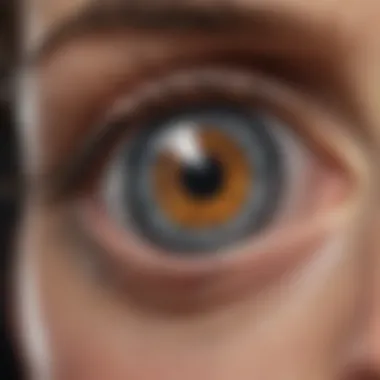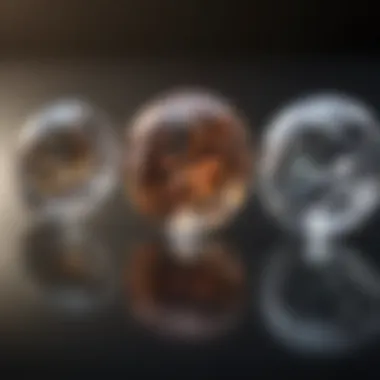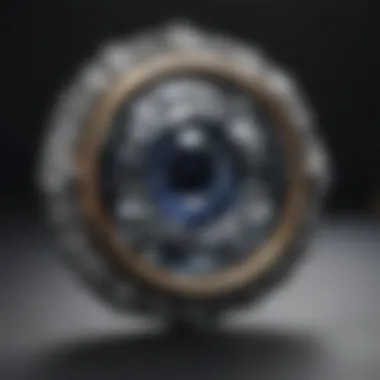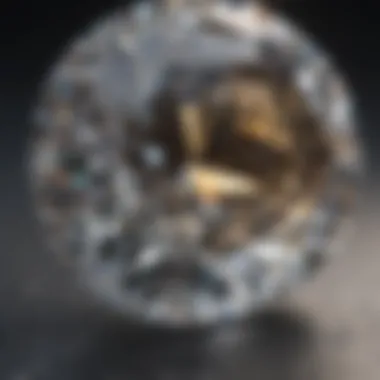Understanding Eye Clean Diamonds: A Comprehensive Guide


Intro
Diamonds are often celebrated for their beauty and brilliance, but not all diamonds are created equal. Among the various quality grades, one term stands out: eye clean diamonds. This term describes diamonds that appear free of inclusions when viewed with the naked eye, thus imparting a sense of quality and allure. Understanding what makes an eye clean diamond valuable is essential for both consumers and jewelers.
This guide will break down the elements that categorize eye clean diamonds, from defining clarity to exploring grading scales and factors that influence perceived cleanliness. It will also touch upon sourcing concerns and how eye clean diamonds fit into the larger gemstone market. By presenting a thorough examination of the subject, this article aims to provide valuable insights to enthusiasts, collectors, and industry professionals alike.
Definition of Eye Clean Diamonds
Eye clean diamonds are defined as gemstones that have no visible inclusions or blemishes when viewed with the naked eye. This grade is crucial because it significantly influences the diamond’s overall aesthetic appeal and market valuation. Understanding the distinction of eye clean diamonds not only benefits consumers and jewelers but also enhances appreciation for diamond quality.
Understanding Clarity in Diamonds
Clarity refers to the presence of internal or external flaws in a diamond. These flaws can be inclusions, which are internal, or blemishes, which are external. The clarity grading scale, established by organizations like the Gemological Institute of America (GIA), categorizes diamonds based on the visibility and size of these imperfections. Eye clean diamonds fall into the higher clarity ranges, typically receiving grades of VS1 (Very Slightly Included) or higher. For people searching for high quality gemstones, clarity is paramount. An eye clean diamond serves as a benchmark for both visual beauty and investment potential.
Characteristics of an eye clean diamond can make it stand out among its peers. Jewely lovers often seek diamonds that are visually appealing without the concern of noticeable imperfections. It is worth noting that a diamond's perceived cleanliness can enhance its desirability in the market, particularly when marketing to consumers who may not be experts in gemology.
Characteristics of Eye Clean Diamonds
Eye clean diamonds possess several distinguishing features. First, they are visually flawless from an average viewing distance. These diamonds reflect light beautifully, contributing to their brilliance and fire. In addition, the cut, color, and carat weight play a role in the overall appearance. Even a diamond that is graded as eye clean may have very minor imperfections when analyzed under magnification. However, these will not be observable in regular use.
- Visual Appeal: The most important characteristic is their capacity for aesthetic beauty.
- Value Retention: Eye clean diamonds typically hold their value better in the market compared to lower clarity diamonds.
- Compatibility in Settings: These diamonds work well in various jewelry designs, making them a versatile choice for both custom jewelery and standard settings.
Understanding eye clean diamonds is essential for anyone looking to invest or purchase quality diamonds. They combine beauty, value, and desirability, resulting in a more favorable option for many collectors and enthusiasts.
Evaluating Eye Clean Diamonds
Evaluating eye clean diamonds is crucial for consumers and collectors in the gemstone industry. This process involves understanding various quality factors that contribute to a diamond's visual appeal and market value. Eye clean diamonds possess a clarity where inclusions and blemishes are not visible to the naked eye. Proper evaluation of these diamonds allows buyers to make informed decisions that align with personal preferences and budget considerations.
The 4Cs of Diamond Quality
Each diamond is assessed based on the 4Cs: Cut, Color, Clarity, and Carat Weight. Each characteristic influences the diamond's overall beauty and value.
Cut
The cut of a diamond refers to how well it has been shaped and faceted. A well-cut diamond reflects light beautifully, maximizing its brilliance. This aspect is vital for eye clean diamonds, as it enhances their appearance. A diamond with an excellent cut often appears larger and more luminous than its actual size. Therefore, the cut is popular among buyers, as it significantly affects perception and desirability.
Color
Color grading measures the presence of any hue in a diamond. The most desirable diamonds are usually near colorless, as these stones appear more brilliant and provide a clearer view of their qualities. For eye clean diamonds, color can play a role in overall aesthetics. A higher color grade can elevate the diamond’s value and attract discerning buyers who seek clarity and beauty.
Clarity
Clarity assesses the visibility of inclusions and imperfections in a diamond. Eye clean diamonds typically fall into the VS1 and VS2 clarity grades, where inclusions are very slight and often undetectable without magnification. This characteristic adds value and appeal because consumers are often willing to pay more for diamonds that appear flawless to the human eye.
However, it is important for buyers to understand that clarity does not solely define a diamond’s beauty.


Carat Weight
Carat weight indicates the weight of the diamond, which also relates to its size. Larger carat diamonds are often more valuable, but the perceived size can also depend on cut and clarity. Buyers should consider that two diamonds with the same carat weight can differ significantly in appearance based on cut quality and clarity. Thus, while carat weight is a notable factor, it is essential to balance it with other characteristics to make a wise purchasing choice.
Professional Grading Standards
Professional grading plays an integral role in assessing and communicating the quality of diamonds. Various certification organizations employ standard criteria to evaluate diamonds, providing consumers with reliable insights into their purchases.
GIA
The Gemological Institute of America, or GIA, is one of the most respected grading organizations. GIA’s grading reports are comprehensive and widely trusted. Their standards for evaluating diamonds emphasize clarity, cut, color, and carat weight. Diamonds graded by GIA tend to command higher market values due to their reputation for rigorous grading processes. This reliability makes GIA a popular choice for buyers.
AGS
The American Gem Society (AGS) is another reputable grading entity known for its detailed assessments. AGS uses an exacting set of standards to evaluate diamonds, particularly focusing on cut quality. Their unique performance-based grading system evaluates how a diamond interacts with light, potentially providing even more useful information for buyers. This thoroughness benefits consumers looking for precision in eye clean diamonds.
IGI
The International Gemological Institute (IGI) offers grading services globally and is recognized for its fast and effective grading reports. IGI provides detailed insights into clarity, color, and cut, making its assessments important for consumers. While IGI reports are respected, some buyers prefer GIA or AGS grading due to perceived variations in stringent standards. It's essential for buyers to understand the differences in organization reputations when evaluating eye clean diamonds.
Visual Inspection Techniques
Visual inspection remains a foundational technique for evaluating diamonds, especially for consumers wanting to assess eye clean diamonds personally. Such inspections involve observing the diamond under various lighting conditions and angles to detect inclusions and flaws. These can include:
- Natural Light: Observing the diamond in daylight can provide a good indication of its color and clarity.
- Magnifying Glass: A 10x loupe helps inspect the diamond closely, revealing any hidden imperfections.
- Different Backgrounds: Examining the diamond against various colored backgrounds or textures can highlight its clarity and overall appeal.
Understanding these visual inspection methods equips buyers with practical tools to evaluate diamond quality effectively.
Comparing Eye Clean and Other Clarity Grades
Understanding the different clarity grades of diamonds is essential for anyone, whether you are a collector, designer, or simply an enthusiast. The term "eye clean" refers to diamonds that appear free of inclusions and blemishes when viewed with the naked eye. However, eye clean is just one grade within a broader diamond clarity grading system. Understanding how this grade compares to others helps in making informed decisions when purchasing or evaluating diamonds.
Understanding Clarity Grading Scales
Diamond clarity is graded primarily using the Gemological Institute of America (GIA) scale, which ranges from Flawless to Included. Here’s a brief overview of this grading system:
- Flawless (FL): No inclusions or blemishes visible under 10x magnification.
- Internally Flawless (IF): No inclusions visible under 10x magnification, only surface blemishes.
- Very Very Slightly Included (VVS1 and VVS2): Inclusions can be difficult to see even under 10x magnification.
- Very Slightly Included (VS1 and VS2): Minor inclusions visible under 10x magnification.
- Slightly Included (SI1 and SI2): Inclusions visible to the trained eye under 10x magnification, but not necessarily to the naked eye.
- Included (I1, I2, and I3): Inclusions that are easily visible to the naked eye and may affect the diamond's brilliance.
Eye clean diamonds typically fall within the VVS, VS, and sometimes SI grades, depending on their specific characteristics. By familiarizing yourself with these categories, you can better gauge the value and visual appeal of a diamond.
Differences Between Eye Clean and Included Diamonds
The distinction between eye clean and included diamonds is significant in both aesthetic and market terms. Eye clean diamonds are visually appealing, making them a popular choice for engagement rings and other fine jewelry. On the other hand, included diamonds possess visible inclusions that may detract from their brilliance and attractiveness.


- Visual Clarity: Eye clean diamonds, even if they fall into the SI category, may still appear flawless to the naked eye, while included diamonds show visible imperfections.
- Market Value: Generally, eye clean diamonds command higher prices than included diamonds due to their attractiveness. Collectors and jewelers often prioritize eye clean clarity for resale value.
- Target Audience: Eye clean diamonds attract buyers who prioritize visual appeal. Included diamonds may appeal more to budget-conscious buyers who seek larger carat weights or specific features despite inclusions.
Market Preferences for Eye Clean Diamonds
In the current jewelry market, the preference for eye clean diamonds tends to dominate discussions. They appeal to a wide demographic, including young couples purchasing engagement rings and those looking for unique pieces in custom designs. Some factors driving this preference include:
- Aesthetic Appeal: Eye clean diamonds reflect light beautifully and appear more brilliant, enhancing their desirability in fine jewelry.
- Investment Potential: Many buyers view diamonds as investments. Eye clean diamonds usually hold their value better than included diamonds, making them a safer choice for long-term investment.
- Consumer Awareness: With easy access to information regarding diamond grading, consumers are more educated about what to look for. This knowledge increasingly leads buyers toward eye clean diamonds, prioritizing visual clarity over mere carat weight.
Investing in eye clean diamonds can offer both beauty and potential financial returns, making them a preferred choice for many buyers.
In summary, comparing eye clean diamonds with their lower clarity counterparts provides insights into market dynamics, consumer preferences, and the overall impact of clarity on diamond value. Buyers should consider these factors carefully to make informed purchases and relevant investments.
Importance of Eye Clean Diamonds
The concept of eye clean diamonds holds a significant position in the diamond market. Understanding the importance of eye clean diamonds is essential for buyers, jewelers, and industry professionals alike. These diamonds are celebrated for their ability to appear flawless to the naked eye, often leading to aesthetic perfection in jewelry. This quality enhances their desirability and value, making them a perennial favorite among consumers.
Aesthetic Appeal and Value
The aesthetic appeal of eye clean diamonds is undeniable. Their visual clarity ensures that any jewelry piece featuring them looks exquisite. Unlike diamonds with inclusions visible to the eye, eye clean diamonds provide an uninterrupted sparkle, enhancing the overall beauty of the stone. The lack of visible imperfections allows for a more captivating brilliance, drawing attention and admiration.
Moreover, eye clean diamonds often command a higher price compared to their included counterparts. Buyers are often willing to pay a premium for this clarity. The perceived value is closely tied to aesthetic factors, making these diamonds not only significant from a decorative standpoint but also as an investment. Jewelry made with eye clean diamonds tends to retain or appreciate in value over time, appealing to collectors and investors.
Role in Custom Jewelry Design
Eye clean diamonds play a crucial role in custom jewelry design. Designers often seek these stones for bespoke pieces, ensuring that the final creation is both elegant and visually appealing. The precision in design benefits from the clarity of these diamonds, as any flaws can detract from intricate designs or settings.
When incorporating eye clean diamonds, custom designers have the freedom to experiment without the worry of noticeable imperfections. This leads to innovative designs that maximize the stone's brilliance. From engagement rings to pendants, eye clean diamonds enhance the aesthetic quality of the jewelry. Additionally, they provide a unique selling point, allowing jewelers to market their creations with a focus on clarity and beauty.
"The allure of eye clean diamonds transcends basic clarity; it encapsulates a commitment to sophistication and artistry in jewelry design."
In summary, the significance of eye clean diamonds can be seen through their beauty, value, and vital role in custom jewelry design. They represent a worthwhile investment for buyers and continue to hold a prominent place in the diamond industry.
Sourcing Eye Clean Diamonds
Sourcing eye clean diamonds is an essential aspect of the overall evaluation and appreciation of these gemstones. The growing demand for such diamonds reflects the awareness of consumers regarding the ethical implications tied to diamond mining. When buyers seek eye clean diamonds, they are not only focused on aesthetic qualities but also on the practices behind sourcing these stones. Awareness about the origins of diamonds and their journey through the supply chain plays a crucial role in ensuring that consumers invest in ethically sourced products. This section will delve into significant elements of sourcing eye clean diamonds, highlighting ethical practices and the intricacies of diamond supply chains.
Ethical Sourcing Practices
Ethical sourcing practices have become increasingly important in today's jewelry market. Consumers are more conscientious about the origins of their purchases. An eye clean diamond should not only possess visual purity but also come from a supply chain that supports fair labor practices and environmental sustainability.
Key aspects of ethical sourcing include:
- Transparency in the sourcing process, ensuring buyers can trace the diamond's journey from mine to market.
- Fair labor practices, where workers are treated well, paid fairly, and work in safe conditions.
- Environmental considerations, which address the ecological impact of diamond mining and promote land reclamation initiatives.


Jewelers and retailers must prioritize these aspects when sourcing eye clean diamonds. Many now seek certifications that prove ethical sourcing, such as those awarded by the Responsible Jewellery Council. Consumers should inquire about a diamond's provenance to ensure their purchase supports ethical practices as they shop.
Understanding Diamond Supply Chains
The diamond supply chain is a complex web, involving various steps from extraction to sales. As potential buyers of eye clean diamonds, understanding this supply chain is vital for making informed decisions. The journey of a diamond typically includes n:
- Mining: The process begins with diamond extraction. This can happen in several places through alluvial and kimberlite mining methods.
- Sorting: Once diamonds are mined, they are sorted based on size, quality, and clarity. This is where eye clean diamonds are identified and separated.
- Cutting and Polishing: The diamonds' original forms require cutting and polishing to optimize their brilliance and ensure they meet clarity standards.
- Retail: Polished diamonds are then sold to retailers, who may also undergo additional selection to ensure they offer quality stones to consumers.
"Understanding the supply chain allows consumers to appreciate the journey of their investment, ensuring they make conscientious choices that reflect their values."
Each stage of this chain holds significance regarding the diamond's impact on people and the planet. By being educated on sourcing methods, consumers can advocate for practices that promote ethical oversight throughout the industry.
Myths and Misconceptions About Eye Clean Diamonds
When discussing eye clean diamonds, it is common to encounter several myths and misconceptions that mislead both consumers and enthusiasts in the gemstone market. Understanding these inaccurate beliefs serves to enhance clarity on the actual attributes of eye clean diamonds, making this topic critical in the larger conversation about diamond quality and value. Recognizing myths allows potential buyers to make informed decisions. Moreover, it aids jewelers and designers in explaining such concepts accurately to their clients. The following sections delve into two prevalent misconceptions that merit substantial discussion.
The 'Perfect' Diamond Myth
One recurring notion is that an eye clean diamond represents a flawless stone. This idea stems from a fundamental misunderstanding of the characteristics of diamonds. While an eye clean diamond does possess a high level of clarity, defined as a diamond showing no visible inclusions to the unaided eye, it does not equate to being perfect.
Flawless diamonds, or those graded as "F" by the gemological labs, are exceedingly rare. In practical terms, this means that a majority of diamonds can exhibit minor inclusions which, when properly assessed, don't reduce the gemstone's overall beauty. For example, a diamond might appear eye clean but still have microscopic inclusions that are only visible under magnification. Therefore, the perception that eye clean diamonds are flawless can misguide consumers about what they are purchasing.
Misunderstanding Clarity vs. Beauty
Another misconception is the belief that clarity is the sole factor determining the beauty of a diamond. Many potential buyers assume that if a diamond is eye clean, it is inherently more beautiful than diamonds with lower clarity ratings. However, beauty is subjective and influenced by multiple characteristics beyond clarity. Factors including cut quality, color, and even personal aesthetic preferences significantly affect a gem's overall appeal.
A well-cut diamond may exhibit remarkable brilliance and sparkle, overshadowing some minor inclusions. Conversely, a poorly cut diamond may fail to catch the light correctly, leading to a dull appearance despite having a high clarity grade. The distinction between clarity and beauty emphasizes the importance of considering all factors when evaluating a diamond.
"Beauty in diamonds is influenced by more than just clarity. Attention to cut, color, and individual taste plays a crucial role."
These misunderstandings about the nature of clarity can lead consumers to prioritize clarity excessively, sometimes missing the true essence of what makes a diamond appealing. Consequently, it is critical to educate oneself on these topics, appreciate various characteristics of diamonds, and ultimately make an informed purchase.
Avoiding these myths and misconceptions can lead to a deeper understanding of eye clean diamonds, enhancing not only the purchase experience but also the appreciation of these remarkable gems.
Eye Clean Diamonds in Historical Context
Understanding the historical context of eye clean diamonds provides essential insight into their valuation and significance in the jewelry market. Clarity has long been a key factor in diamond evaluation. Over time, societies have attributed various meanings and values to clarity, altering consumer perceptions and market dynamics.
Evolution of Diamond Evaluation Standards
The methods for assessing diamond quality have undergone significant transformations since the early days of gem exploration. Initially, diamonds were often judged based on their visual aspects, primarily focusing on size and color. Clarity measurements began to take shape in the 20th century when organizations like the Gemological Institute of America (GIA) established standardized grading systems. This formalization of grading helped everyone, from consumers to jewelers, have a common language regarding diamond quality.
Today, the GIA defines clarity grades, which include categories from Flawless to Included, and eye clean diamonds sit comfortably between these classifications, often appealing to those looking for quality without imperfections. This evolution reflects not only advancements in gemological science but also changing consumer preferences. As buyers became more aware and educated, demand for diamonds with specific clarity characteristics, like eye clean diamonds, increased considerably.
Cultural Significance of Diamond Clarity
Culturally, diamonds symbolize more than aesthetic appeal; they represent status, love, and commitment. The clarity of a diamond often correlates with its perceived value. In many cultures, an eye clean diamond is considered a mark of quality and desirability. This significance can be traced back to historical customs surrounding engagement rings and decorative pieces, where clarity emphasized purity and devotion.
Moreover, the notion of clarity has impacted various industries, notably in custom jewelry design, where individual preferences shape the final product. Jewelers now often market eye clean diamonds to highlight their blend of beauty and value. The awareness and appreciation for diamond clarity, especially eye clean attributes, has evolved into a significant driving force in consumer decisions.
“Diamonds are forever, and their clarity reflects the finest aspects of love and commitment.”



